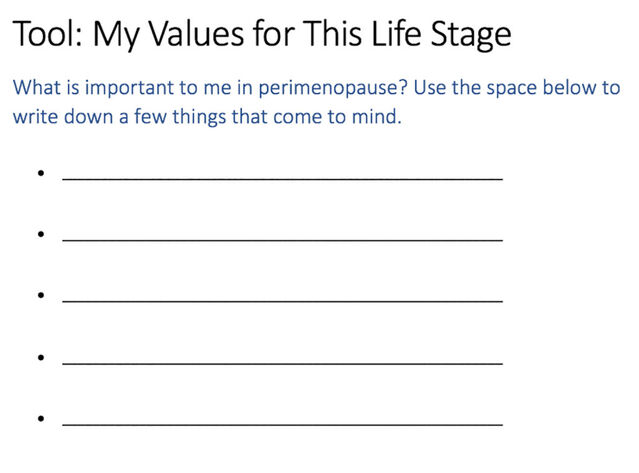Menopause
3 Steps for a Healthy Perimenopause
Are you experiencing symptoms of perimenopause?
Posted July 20, 2021 Reviewed by Ekua Hagan
Key points
- Perimenopause typically starts in mid to late 40s and is characterized by symptoms such as mood changes, sleep problems, and changes in weight.
- Acceptance and commitment training (ACT) can help minimize the challenges of perimenopause and boost one's well-being.
- Ultimately, an integrative approach that combines conventional medicine with alternative treatments can ease perimenopause symptoms.
Perimenopause. The life stage leading up to and around menopause, the one you may not have heard of until you reached it, can bring physical and emotional challenges. It typically starts in the mid to late 40s. If you’re under 40 and read our post explaining perimenopause, you may be a bit apprehensive about what’s coming next.
But fear not. As with every life stage, there are benefits as well as challenges. One of the benefits of perimenopause is the chance to lay a foundation for your best health in the future. Along with our favorite mind-body techniques, including regular exercise, meditation, journaling, and practicing gratitude, an approach from the field of positive psychology can be helpful in navigating this life transition.
Read on to learn how you can use acceptance and commitment training (ACT) to minimize the challenges of perimenopause and boost your well-being.
Perimenopause symptoms and challenges
“It’s like playing Whack-a-Mole,” says Neela. “Hot flashes, night sweats, forgetfulness, sex not so comfortable anymore — as soon as I get one problem tackled, another one pops up.”
The physical transitions in our lives can bring a parade of physical, mental, and emotional changes due to shifting hormones and circumstances. If you had children, you likely recall the physical, mental, and emotional changes of pregnancy, from constipation to weepiness to the “nesting urge.” However, you likely accepted these inevitable changes as part of pregnancy.
Adolescence is a similar life stage. Remember the emotional ups and downs and unexpected acne blemishes? Or how your period seemed like it could start any time? In some ways, perimenopause is the bookend to a biological woman’s reproductive life. The hormone shifts of perimenopause spark some of the same changes as adolescence but in reverse.
Perimenopause, which starts at an average age of about 47, lasts from four to eight years. The list of possible symptoms is a long one:[i]
- Mood changes (e.g., depression, anxiety, irritability, panic attacks, etc.)
- Menstrual period changes
- Dryness — of the eyes, mouth, skin, and vagina
- Pain with sex, less interest in sex, or both
- A tendency to leak urine
- Sleep problems
- Changes in weight and body shape
- Joint pain
- Memory problems
- Headaches, including migraine
Fortunately, the same thing that helped you cope with other stages of life — focusing on what you valued most, whether it was a pathway to adulthood or the prospect of a child — can also help with perimenopause.
Adding acceptance and commitment to your health practices
Mindfulness and gratitude are two of the mind-body practices we often mention because they are proven to help increase health and well-being. They can help minimize anxiety, stress, and depression in the perimenopause transition. Along with regular exercise, quality sleep, and an anti-inflammatory diet, they can relieve symptoms such as hot flashes and minimize the side effects of medical treatments. To boost your overall sense of well-being, you can try mindfulness meditation with Dr. Jonas in a short session that helps you breathe through and release any tension or pain.
Mindfulness is a key component of ACT.[ii] Watch a video explaining how ACT works and read on to learn more about how this approach can be part of your personal integrative approach to perimenopause.
Step 1: Recognize and accept perimenopause symptoms
A cornerstone of ACT is recognizing and accepting what you see as negative. For example, Sherri is so bothered by her hot flashes that she tries not to think about them and gets upset when they happen. (Of course, stressing out about having a hot flash sometimes makes the hot flash worse.) She hates to think what would happen if someone at work noticed her looking flushed, red, and sweaty instead of cool and collected.
Using ACT to deal with hot flashes would include leaning into these events and her thoughts about them. Sherri might jot down a few words and phrases that come to mind when she has a hot flash, such as “sticky,” “sweaty,” or “embarrassed.” She might notice some darker thoughts, such as “This is inappropriate,” “I’m getting old and unattractive,” or even “I might be fired because I’m not young.”
Normally, Sherri pushes those thoughts away. She focuses on escaping the hot flash — leaving the room, splashing her face with water, and hoping it doesn’t happen again soon. With ACT, she allows the words, phrases, and thoughts to run through her mind until they lose their power to upset her. In the words of Dr. Steven Hayes, originator of ACT,[iii] this is called “defusion.” (You can learn more ways to defuse painful thoughts here.)
Finally, Sherri puts her stressful thoughts in perspective. They are just thoughts, not reality. This helps her feel less stressed.
Step 2: Commit to living your values with gratitude
It may seem strange to talk about values related to a specific life stage. But when you think back, you probably held certain values during other transitions, such as adolescence, young adulthood, or pregnancy. These might have included becoming independent, discovering your life purpose, having a healthy pregnancy, or being the best parent you could be.
What do you value most as you transition to menopause? Maybe it’s feeling as well as possible, having the stamina to travel or keep up with your teenagers, or preventing a health condition that runs in your family. Writing down a few of the things you value and want in your life can help you focus on the health goals rather than negative feelings. Adding a gratitude practice can help you remember what is already going well in your life. You might even discover that you’re grateful for a few of the changes of perimenopause.
One woman’s example
Sherri decided that one of her values was to feel as good as possible despite being bothered by hot flashes. Part of living out this value was avoiding the nighttime hot flashes, also called night sweats, that had been waking her up regularly. Another component was feeling confident at work, with less anxiety about when a hot flash might occur. She also decided to practice gratitude for all the times she did feel just fine.
Sherri talked to her nurse practitioner and decided to try a prescription hormone patch. She also committed to some changes in her bedroom environment and sleepwear. Instead of denying that she had hot flashes at night (“I’m just hot!”) she acknowledged that they were part of a larger life change.
To make herself more comfortable, she added a portable fan to keep things cooler, purchased some wicking pajamas designed specifically for women in perimenopause, and cut out caffeine after noon. Her husband was OK with her opening the window at night, too. She also purchased a beautiful journal to keep on her nightstand. Each night before sleep, she wrote down five things she was grateful for that day — things that went well or ways she felt good.
When she did have a hot flash, Sherri noted that she felt uncomfortable, sweaty, and embarrassed, but that those were simply her feelings — not a sign of impending disaster. She practiced gratitude — for her portable fan, her iced herbal tea, or even just not being at work when a hot flash happened. She continued with the changes she had made, and she had fewer hot flashes and felt better in a few weeks.
Accepting what was happening, deciding what was important to her, and committing to pursue what she wanted made Sherri feel calmer and more in control.
Step 3: Learn more about integrative health and perimenopause
An integrative health approach to perimenopause means caring for your body, mind, and spirit during this long period of transition. It combines conventional medicine with complementary and alternative (CAM) approaches, such as acupuncture and aromatherapy, and self-care approaches, such as getting a massage or practicing yoga.
Because perimenopause lasts four to eight years, you have a major opportunity to develop enduring habits. As you consider an integrative health approach, you can ask the following questions:
What techniques or treatments help you feel better physically?
What helps you feel better emotionally, mentally, and spiritually?
Who can help you during your perimenopause transition? Who is in your circle of support? You may want to find a health care provider who specializes in menopause and perimenopause care.
Once you have created a short list of wants and values, your next step may be to choose one or two to start putting into practice. You can use the tool below to get started.
An integrative approach can help you and your health care provider personalize your care during perimenopause, support your health and well-being, and prepare for a rewarding future.

This post is part of a series dedicated to perimenopause. Read our previous posts, “Peri-what? Know Your Perimenopause” and “Integrative Health in Perimenopause.”
**Co-authored by Genevieve Walker, Ph.D., a medical writer with more than 15 years of medical writing experience and 25 years of healthcare experience.
References
North American Menopause Society. Menopause 101: A primer for the perimenopausal. Available at http://www.menopause.org/for-women/menopauseflashes/menopause-symptoms-and-treatments/menopause-101-a-primer-for-the-perimenopausal. Accessed July 1, 2021.
[ii] LaPilusa J. Acceptance and commitment therapy (ACT). Updated February 2, 2018. Available at https://www.goodtherapy.org/learn-about-therapy/types/acceptance-commitment-therapy. Accessed July 1, 2021.
[iii] About. www.StevenCHayesPhD.com/about. Accessed July 1, 2021.




